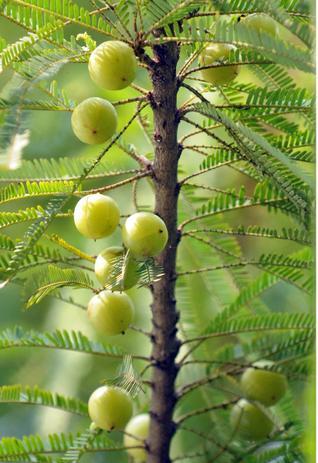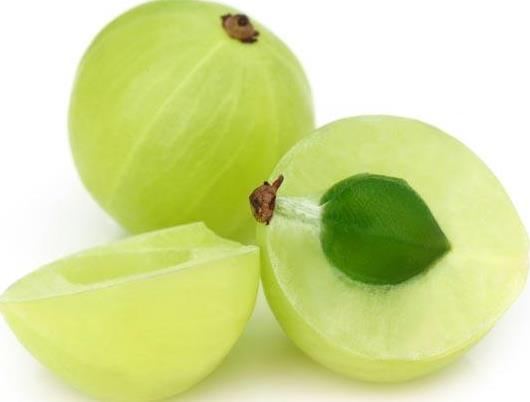Gooseberry Farming Guide:

Introduction of Gooseberry Farming:- Gooseberry or Indian Gooseberry or Amla or Aonla is an indigenous tropical/sub-tropical fruit to the Indian subcontinent. Due to its medicinal and nutrition importance, this fruit has become famous for its commercial use. Indian gooseberry is a hardy plant which can be grown in waste lands. The best part of this tree is; this can survive in extreme hot and cold climatic conditions. Commercial growers of Indian gooseberry (Amla) can obtain excellent yields with minimum care or maintenance. Gooseberry is an excellent source of vitamin ‘C’. When it comes to the tree description, it is a small to medium sized deciduous tree which can be grown up to 10 meters in height with crooked trunk and spreading branches. This tree fruits are in spherical shape with green to pale yellow in colour. Gooseberry/Amla has very good demand from the industries for the preparation of various health care products like hair oil, dye, shampoo, face creams and tooth powder other than using in culinary preparations. With proper orchard management practices, farmers can get huge profits in gooseberry farming. Let us go through the cultivation of gooseberry from seeding to harvesting in the following write up.
Scientific Name of Gooseberry:- Ribes uva-crispa.
Genus of Gooseberry:- Ribes.
Family Name of Gooseberry:- Grossulariaceae.
Gooseberry Names in Other Parts of World:- Uva spina (Italian), Appelliefie (Afrikaans), Kruisbes (Dutch), Stachelbeere (German), тошлой (Mangolian), Agrest (Polish), grosarts (Scottish), miro yar (Somali), رسیلی گول رسبھری (Urdu), ogrozd (Bosnian), Karusmari (Estonian), Lagokeraso (Greek), spíonÚn(Irish), Guseubeli (Korean), Cawsla (Maltese), Amalaa (Nepali), Amla (Hindi, India), Groselha (Portuguese), Ogroz (Serbian), Grosella (Spanish), عنب الثعلب (Arabic), Tsarigradsko grozde (Bulgarian), 醋栗/culi (Chinese), Gansang-ratiles (Filipino), Makhampom/ผลกูสเบอร์รี่ (Thai), quả lí gai (Vietnamese), Stikkelsbær (Norwegian), Kokrrosheni (Armenian), gūzuberī/セイヨウスグリ (Japanese), ērkšķoga (Latvian), Agriș (Romanian), නෙල්ලි ( Sinhalese, sri lanka),kantuot (Cambodian), angrešt (Czech),Groseillier à maquereau (French), цариградско грозде (Macedonian), Krusbär (Swedish), Bektaşi üzümü (Turkish), Stikkelsbær (Danish), კინკოიჟა (Georgian), Egres (Hungarian), Gusberi (Malay), انگور فرنگی (Persian), 鵝莓 (Taiwanese), Karviaismarja (Finnish),
Common Names of Gooseberry:- Emblic, emblic myrobalan, myrobalan, Indian gooseberry, Malacca tree, amla, Amlaki, Aonla, Amlika.
Gooseberry Local Names in India:- Gooseberry / Amla (English), Nellikai (Tamil), Nellikka (Malayalam), Usiri / Usirikayi (Telugu), Awalah (Marathi), Nellikai (Kannada), Amla / Amlaka (Hindi), Amlaki / Amla (Bengali), Ambala / Amla (Gujarati), Avalo (Konkani), Anla (Oriya), Amla (Punjabi), Nelli (Tulu).
Top Ten Production Countries of Gooseberry:- The following are top ten production countries of Gooseberry in the world.
- Germany
- Russia
- Poland
- Ukraine
- Czech Republic
- UK
- Austria
- Hungary
- Denmark
- Lithuania.
Health Benefits of Gooseberry:- The following are some of the health benefits of Indian Gooseberry.

- Good for eye health.
- Good for hair.
- Good for digestion and prevents from constipation.
- Prevents from certain type of cancers.
- Good for brain health.
- Improve skin health.
- It has anti-aging properties.
- Excellent for diabetic patients.
- Boosts Immunity due to presence of vitamin ‘C’.
- Gooseberry is rich in antioxidants, iron, calcium, anthocyanin, flavonoids, and potassium, hence good for heart.
Varieties of Gooseberry:- The cultivars (varieties) depends on the region. There are many improved hybrid gooseberry varieties available specific to the region. Find out with your local horticulture department suitable cultivar for your region. In south Asia, especially in Indian region; the varieties recommended for high yielding cultivation are Banarsi, Francis, Chakaiya, Kanchan (NA-4),Krishna (NA-5),Narendra-6 (NA-6),Narendra-7 (NA-7),Narendra-9 (NA-9) and Narendra-10 (NA-10).
Climate Requirement for Gooseberry Farming:- Indian gooseberry/Amla is grown in both tropical and sub-tropical regions. Indian gooseberry is very sensitive to frost. Though this tree can survive thorough drought periods, good irrigation or annual rainfall will result in good quality and yield. Generally it requires 650-800 mm of annual rainfall for its proper growth. The young gooseberry plants up to the age of 2-3 years should be protected from hot winds during summer and from frost during winter months. Anyway the mature plants can tolerate freezing temperature as well as a high temperature up to 45°C.
Soil Requirement for Gooseberry Farming:- Well, Gooseberry plants can be grown in wide range of soils. However, Light as well as medium heavy soils except purely sandy soils are ideal for Gooseberry cultivation. These trees are well adapted to dry regions and can also grow in moderately alkaline soils. Heavy soils or high water table areas are not suited for gooseberry cultivation. A soil pH of 6.5 to 8.5 is ideal for Amla/Gooseberry crop. Commercial growers should conduct soil test for soil fertility.
Propagation in Gooseberry Farming:- Indian Gooseberry is usually propagated by seeds, but seedling plants bear inferior/poor quality fruits with small size and have a long gestation period. However, commercial growers prefer grafted plants. Gooseberry can be propagated through different vegetative methods such as cleft grafting and patch and ring budding, shield budding. Most recommended propagation method is shield budding. Budding is done on 1year old seedlings with buds collected from superior varieties yielding big sized fruits.
Season for Gooseberry Sowing:- If the region expects good rains, it can be planted onset of monsoons. However, these trees can be grown throughout the year with proper irrigation.
Seed Treatment in Gooseberry Farming:- Seed propagation is not recommended for commercial growers. However, if this method is opted, for better germination, collected seeds should be treated with 200-500 ppm Gibberelic acid. Usually, gooseberry seeds take 8 to 10 days to germinate.
Land Preparation, Seed Rate, Sowing and Spacing Gooseberry Farming:- Give couple of ploughings with local tractor to bring the soil to fine tilth and remove any weeds or branches from previous crop. The pits of 3 feet x 3 feet x 3 feet should be prepared at a distance of 10 feet spacing during May-June or before rainy season starts. These pits should be left for 3 to 4 weeks exposed to sunlight. Each pit should be filled with surface soil mixed with 15 to 20 kg well decomposed farm yard manure (FMY) like cow dung or any other organic matter (garden compost) and 1 kg of super phosphate before planting the grafted seedling. Healthy plant grafts or budded plants should be planted during rainy season preferably during the early monsoon with square system. When it comes to plant density, generally 1 acre land can accommodate 200 seedlings.
Irrigation in Gooseberry Farming:- Indian gooseberry is a hardy plant and does not require any water in rainy season. However, for proper tree /root establishment, the young plants require irrigation during summer months at 2 weeks interval till they are fully established. The critical stages of flowering and fruit bearing stage require a irrigation at 2 weeks interval as well. Drip irrigation is best method for proper water utilization, effective fertigation and weed control at basin.
Manures and Fertilizers in Gooseberry Farming:- With proper schedule of manures and fertilizers will ensure the healthy tree establishment and quality of fruit set along with high yield of crop.
| Manures/Fertilizers | Per Acre | Per Hectare |
| FMY (Farm yard manure) | 5 tonnes | 10 to 12 tonnes |
| ‘N’ | 90 kg | 225 kg |
| ‘P2O5’ | 120 kg | 300 kg |
| ‘K2O’ | 50 kg | 120 kg |
Training and Pruning in Gooseberry Farming:- Pruning and Training operations in any orchard management will ensure proper tree establishment with strong framework. Generally dead, sick/weak crisscrossing branches and suckers should be pruned off and only 4-5 well shaped healthy branches with wide angle at about 0.75-1.0 meter from the ground level should be left.
Mulching in Gooseberry Farming:- Mulching provides the best way of protecting water content from plant base and controlling weeds. Mulch material like paddy straw or wheat straw or dry leaves can be placed at the base of the tree up to 15-20 cm from the trunk.
Inter crops in Gooseberry Farming:- Farmers can generate extra income by utilizing the space between gooseberry trees during first 5 to 6 years. Any short grown crops like, green gram, black gram, cow pea, horse gram or any vegetable crops can be cultivated intercrops in Gooseberry farming. When intercrops are grown, inputs like manures/fertilizers/irrigation should be supplemented in addition to the inputs required for main gooseberry crop.
Control Measures of Weeds in Gooseberry Farming:- For healthy tree growth and well maintained orchard, regular weeding and hoeing should be carried out. Young Gooseberry trees should be protected from direct sunlight, hot winds and frost in winters by installing tree guards during first two years. Any dead or diseased branches or sick trees should be removed.
Pests and Diseases in Gooseberry Farming:-
- Pests and Their Control Measures in Gooseberry Farming:
| Type of Pests | Symptoms | Control Measures |
| Leaf roller | Leaflets turn pale brown or dark brown.
|
Destroy infested plant parts along with leaf roller.
Spray application of dimethaote 0.03% and quinalphos 0.025%. |
| Fruit Borer | Larva bores into the fruit in different phases of fruit growth.
|
Collect and destroy damaged fruits.
Spray Neem oil 3%.
|
| Fruit Piercing Moth | Sucks the sap from fruits. | Use light trap.
|
| Bark Borer | Make tunnels in the main trunk and branches
|
Spot application of fenthion in 1 liter of water.
Collect loose and damaged bark & destroy.
|
| Aphids | Suck sap by remaining on the under surface of leaves and result in yellowing of leaves.
|
Spray neem oil at 3%.
|
| Whitefly | Suck sap from under surface of leaves and make the leaves turn yellow. | Spray neem seed kernel extract 5% (50 kg) and neem oil at 5 ml/liter.
Spray fish oil rosin soap 25 kg at 1 kg in 40 lit of water.
|
| Mealy Bug | Sucks the sap.
|
Early detection of mealy bugs – presence of ants – indicator.
|
- Diseases and Their Control in Gooseberry Farming:
| Type of Disease | Symptoms | Control Measures |
| Rust | Appears as circular reddish solitary or gregarious on leaves and also on fruits. | Spray 0.2 per cent Mancozeb at an interval of 7 to 28 days. |
| Fruit Rot | Water-soaked spots on fruits, which swell and turn yellow, brown and finally black. | Timely treatment and control measures are needed. Contact local horticulture department for proper treatment.
|
Note: Your local agriculture/horticulture department is good source for finding suitable solutions for controlling pests and diseases in Gooseberry Farming.
Harvest in Amla-Gooseberry Farming:- Amla/Indian gooseberry tree (budded) starts bearing fruits after about four to five years of planting depending on the cultivar grown. Usually, fruits are harvested when they become dull greenish yellow from light green. One can harvest by vigorous shaking or using long bamboo poles attached with hooks.
Yield in Gooseberry Farming:- Well yield of any crop depends on many factors such as cultivar (variety), soil type, climatic conditions of the region, irrigation facility, age of trees and other farm management practices. However, gooseberry tree yields better than any other tree crops in adverse conditions. A mature Amla/Gooseberry tree of about 10 years will yield 50-80 kg of fruit. The average weight of the fruit is 60-75 grams and 1 kg contains about 15-19 fruits. A well maintained orchard yields up to an age of 60-70 years.
Marketing of Gooseberry:- Freshly harvested fruits can be transported to local markets or can supply to any herbal/pharmaceutical industries on large scale. It is advised to have a contract of marketing before going for commercial production of gooseberries.
